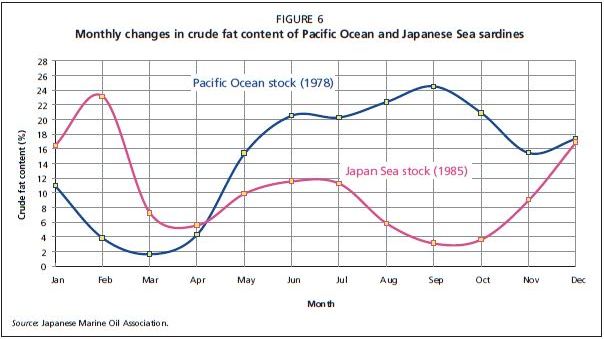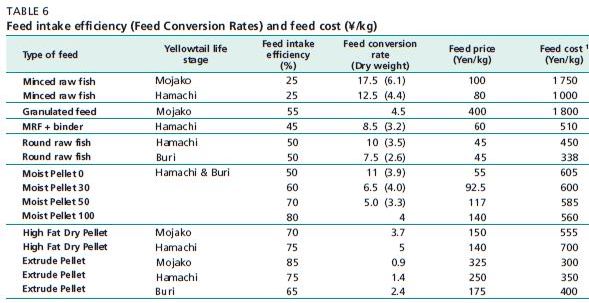FISH FEED
Reliance on wild-caught food
In the early years of yellowtail culture in Japan, there was a high dependence on locally available trash fish for feed. However, as yellowtail culture techniques were disseminated, the demand for trash fish exceeded production, and different resources had to be used that included commercially available small pelagic fish such as sardines which were abundant and cheap. The government supported the installation of large-scale freezing plants along the coast and frozen sardines further supported the development of yellowtail aquaculture. Minced frozen sardines were widely used; however feeding efficiency was poor and water quality deteriorated rapidly due to accumulation of uneaten fish and faeces.
However, after determining that feeding frozen fish was safe, and was better than feeding thawed fish, frozen sardines were fed cut into pieces or whole (Miyazaki, 1986). Two of the major advantages with the use of frozen fish were reduced deterioration of the feed and reduced environmental pollution.
However, the use of sardines alone as the sole feed for yellowtail led to nutritional disorders, because of unsuitable calorie/protein levels. Furthermore, the crude fat content of sardines changed markedly with harvest areas and seasons (Table 4), and between the stocks in the Pacific Ocean and Japanese Sea (Figure 6). While a good system for distributing sardines to fish farmers was developed, there was no control over their fat content. There is a strong, negative correlation between the water and fat content of sardines landed at Kyushu, Sanin and Kushiro.
Table 4
Difference in crude fat content of sardines according to harvest area

Sources: Japan Marine Oil Association.
Capture-based aquaculture of yellowtail 209
FIGURE 6
Monthly changes in crude fat content of Pacific Ocean and Japanese Sea sardines

Source: Japanese Marine Oil Association.
More recently, the catch of wild fish as feed has markedly declined. For example, the harvest of sardines between 1980 and 1990 was more than four million tonnes. These were used to feed farmed fish such as yellowtail, red seabream, and silver salmon as well as being transformed into fishmeal. However, after 2003 only 50 000 tonnes of sardines were locally fished. Fresh fish feed for yellowtail farming decreased over the years from 1.7 million tonnes to 0.88 million tonnes (including mainly sardines, horse mackerel, mackerel and sand lance). At the same time the total production of cultured yellowtail has been maintained at around 150 000 tonnes due to the development of artificial feeds such as moist and extruded pellets (Table 5).
TABLE 5
Temporal changes in quantities of fish and artificial feeds used in yellowtail aquaculture (tonnes), 1994–2006

TABLE 6
Feed intake efficiency (Feed Conversion Rates) and feed cost (?/kg)

1 Cost of feed to produce a kg of fish.
Extruded pellets containing more than 20 percent fat are efficiently utilized by yellowtail, and farmers have achieved feed conversion ratios of 1.2 during the production of 1-year old fish. Using the same type of feed, satisfactory growth has also been achieved during the second year, providing that water temperatures are optimal. For yellowtail larger than 3 kilograms, raw fish is preferred to extruded pellets, and it is difficult to attain daily feeding rates of 2 percent of the body weight on extruded pellets, especially during the winter. Development of an extruded pellet, containing >25 percent fat and weighing more than 30 g, will be required for the economical production of yellowtail larger than 3 kilograms, particularly during the winter months.
Artificial feed availability and problems
Artificial feeds support improved growth and survival rates when compared to fresh fish diets. When raw fish were used as the primary feed material for yellowtail, it was difficult to predict fish growth precisely because the nutritional composition of the feed varied significantly. As information on the protein and vitamin requirements of yellowtail was acquired (Takeuchi et al., 1992), the production of various types of moist pellets and formulated feeds became possible. Currently the production cost for yellowtail moist pellets or formulated feed is less than that of raw fish, prompting numerous feed manufacturers to produce such feeds.
Although the quantity of formulated feed used for yellowtail culture has increased almost linearly over the last decade (see Table 5), more research is needed to develop dry pelleted feed, appropriate feeding techniques and identification of inexpensive feed materials (Nakada, 1997a; Shimeno, Masaya and Ukawa, 1997; Nakayama, 1997). The development of high quality formulated fish feeds is now being undertaken by the Fisheries Agency of Japan, the Fish Feed Association of Japan, university researchers and fisheries experimental stations (Matsumoto, 1997). The development of artificial feeds such as Umisachi and Otohime has contributed to the increased production and high survival of Mojako. By using such feeds it is now possible to raise healthy Mojako starting from initial sizes of >2 g; when raw minced fish was used as feed, high survival rates were not possible.
The Fish Feed Association of Japan supported the development of economical moist pellets, extruded pellets and granulated feeds for yellowtails that successfully lowered production costs and improved product quality. In addition, pharmaceutical companies developed vitamin mixtures and functional ingredients for the prevention and treatment of disease and improvements of fish quality.
Another advance in artificial feed came in 1979 when the Japanese Fisheries Agency started to develop a moist pellet diet for yellowtail culture in order to prevent pollution. However, during the 1980s the abundant and extremely cheap domestic spot-lined sardines continued to be used as the principal feed for yellowtail. It was not until the early 1990s that fish farmers finally became aware of the severe damage to the environment around their aquaculture grounds caused by feeding fish, and this prompted acceptance of the artificial feeds
Modification to the feed can include the addition of binding agents, which, when added to minced raw fish, improve the feed efficiency by almost twofold. The daily feeding rate can then be reduced by 20 to 30 percent, resulting in a better feed conversion rate and reduced water pollution. The use of the right feed in the appropriate amount is a very important factor for efficient and sustainable production, which can in turn improve cultured fish quality (Table 6).
Various substitutes for fishmeal have been successfully used to halve the amount of fishmeal and fish oil in yellowtail feeds without adverse effects (Watanabe, 1996; Shimeno, 1997; Shimeno, Takii and Ono, 1993). If defatted and dried fishmeal is used in aquaculture, fish feeds have insufficient lipid content in the absence of added fat (Nakada, 1992).
During the 1980s it was common practice to provide supplemental oil in feed for freshwater fishes, however, these oils could not be used for marine species due to their difference in fatty acid requirements. Feed oils suitable for marine species were developed and tested in commercial production trials with yellowtail, and produced fish similar in lipid composition to wild fish. However, the quality of oil containing high levels of highly unsaturated fatty acid (HUFA) varies, so the Society of Aquaculture Feed Oil Research has set standards for feed oils recommended for aquaculture feeds. Since world production of fishmeal and fish oil has fluctuated dramatically, further improvements in fish feeds, including use of alternative protein sources, has been undertaken. In the future, soybean meal, poultry meal and a certain amount of fish oil, along with soybean oil and/or coconut oil, will likely be used in place of the current fishmeal which is currently the major protein source in formulated feeds.
Sustainability of wild-caught feed
Under strict regulations from the Japan Fishery Ministry, the sardine resources are stable at low harvest levels. According to the 2004 statistics of the Japan Fishery Agency, feed fish production for yellowtails was 525 000 tonnes, and artificial feed production for yellowtails was 357 000 tonnes. As the sardine stocks are not increasing, sardines should not be harvested at levels greater than the previous year, and yellowtail culture will need to switch to artificial feeds.